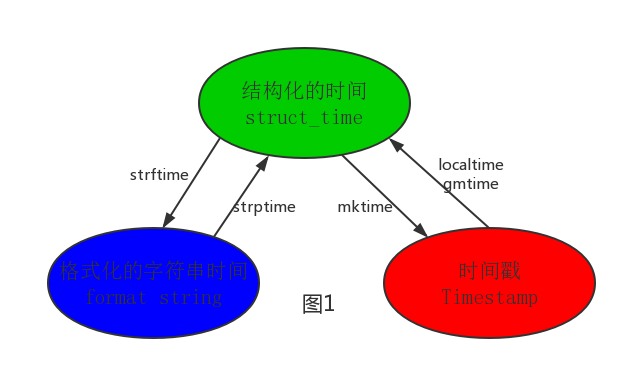目录
时间模块
1 时间模块优先掌握的操作
1.1 time模块
时间分为三种格式:
1.1.1 时间戳
时间戳是从1970年到现在经过的秒数
作用:用于时间间隔的计算
import time
print(time.time())
1.1.2 格式化时间
按照某种格式显示的时间:2020-03-30 11:11:11
作用:用于展示时间
import time
print(time.strftime('%Y-%m-%d %H:%M:%S %p'))
print(time.strftime('%Y-%m-%d %X'))
%a Locale’s abbreviated weekday name.
%A Locale’s full weekday name.
%b Locale’s abbreviated month name.
%B Locale’s full month name.
%c Locale’s appropriate date and time representation.
%d Day of the month as a decimal number [01,31].
%H Hour (24-hour clock) as a decimal number [00,23].
%I Hour (12-hour clock) as a decimal number [01,12].
%j Day of the year as a decimal number [001,366].
%m Month as a decimal number [01,12].
%M Minute as a decimal number [00,59].
%p Locale’s equivalent of either AM or PM. (1)
%S Second as a decimal number [00,61]. (2)
%U Week number of the year (Sunday as the first day of the week) as a decimal number [00,53]. All days in a new year preceding the first Sunday are considered to be in week 0. (3)
%w Weekday as a decimal number [0(Sunday),6].
%W Week number of the year (Monday as the first day of the week) as a decimal number [00,53]. All days in a new year preceding the first Monday are considered to be in week 0. (3)
%x Locale’s appropriate date representation.
%X Locale’s appropriate time representation.
%y Year without century as a decimal number [00,99].
%Y Year with century as a decimal number.
%z Time zone offset indicating a positive or negative time difference from UTC/GMT of the form +HHMM or -HHMM, where H represents decimal hour digits and M represents decimal minute digits [-23:59, +23:59].
%Z Time zone name (no characters if no time zone exists).
%% A literal '%' character.
格式化字符串的时间格式
1.1.3 结构化的时间
作用:用于单独获取时间的某一部分
import time
res=time.localtime()
print(res)
print(res.tm_year)
print(res.tm_yday)
# time.struct_time(tm_year=2020, tm_mon=3, tm_mday=30, tm_hour=22, tm_min=22, tm_sec=17, tm_wday=0, tm_yday=90, tm_isdst=0)
# 2020
# 90
1.1.4 sleep
可以将代码等待一定时间
import time
time.sleep(3)
1.2 datetime模块
import datetime
# 可以直接做时间的加减
print(datetime.datetime.now())
print(datetime.datetime.now() + datetime.timedelta(days=3))
print(datetime.datetime.now() + datetime.timedelta(weeks=1))
2 时间模块需要掌握的操作
2.1 时间格式的转换

2.1.1 struct_time->时间戳
import time
s_time=time.localtime()
print(time.mktime(s_time))
2.1.2 时间戳->struct_time
import time
tp_time=time.time()
print(time.localtime(tp_time))
print(time.localtime())# 本地时间
print(time.gmtime()) # 世界标准时间
print(time.localtime(333333333))
print(time.gmtime(333333333))
2.1.3 struct_time->格式化的字符串形式的时间
import time
s_time=time.localtime()
print(time.strftime('%Y-%m-%d %H:%M:%S',s_time))
2.1.4 格式化的字符串形式的时间->struct_time
import time
print(time.strptime('1988-03-03 11:11:11','%Y-%m-%d %H:%M:%S'))
2.1.5 format string<------>timestamp
# 如果想实现'1988-03-03 11:11:11'+7天
# format string--->struct_time--->timestamp
struct_time=time.strptime('1988-03-03 11:11:11','%Y-%m-%d %H:%M:%S')
timestamp=time.mktime(struct_time)+7*24*3600
print(timestamp)
# format string<---struct_time<---timestamp
res=time.strftime('%Y-%m-%d %X',time.localtime(timestamp))
print(res)
3 时间模块仅需了解的操作
import time
print(time.asctime())
# Mon Mar 30 22:34:59 2020
import datetime
print(datetime.datetime.now())
# 2020-03-30 22:34:59.313774
print(datetime.datetime.utcnow())
# 2020-03-30 14:34:59.313774
print(datetime.datetime.fromtimestamp(333333))
# 1970-01-05 04:35:33
4 实例应用:打印进度条
import time
def progress(percent):
if percent > 1:
percent = 1
res = int(50 * percent) * '#'
print('
[%-50s] %d%%' % (res, int(100 * percent)), end='')
recv_size=0
total_size=1025011
while recv_size < total_size:
time.sleep(0.01) # 模拟下载了1024个字节的数据
recv_size+=1024 # recv_size=1024
percent = recv_size / total_size # 1024 / 333333
progress(percent)